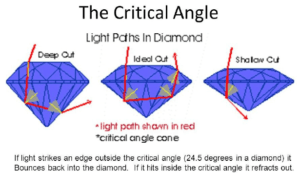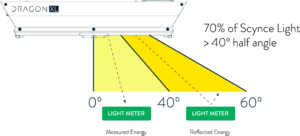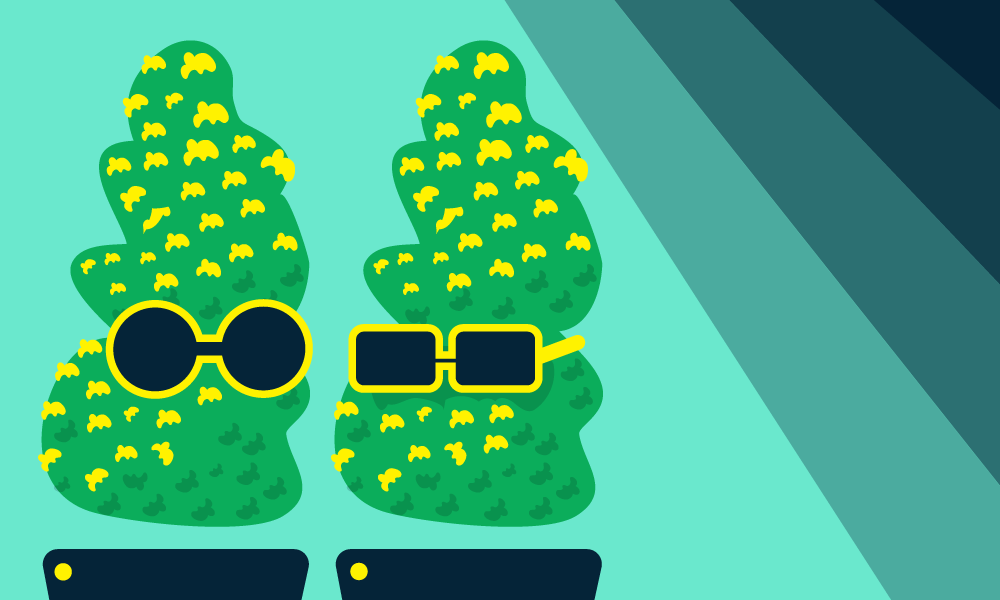Just as humans need to eat fruits, vegetables, grains and protein to survive, plants need light to photosynthesize. It’s their food. That’s why it is so important to scrutinize and optimize the light your plants are getting. Daily or weekly measurement of this light is a critical function of any grower.
One thing we hear quite a bit is, “I can’t get the same readings on my PAR meter that you show on your simulations.” That is absolutely correct! Because all of our lights utilize custom (patented) optics, the bulk of our light exceeds the critical angle of the sensor. “What is the critical angle” you ask? In simple terms it is when the measurement sensor can’t absorb the light that hits it at too great of an angle. Instead of getting measured, it reflects off and results in total PPFD readings that are lower than the true energy reaching the plants.
CRITICAL ANGLE
– the angle which any surface or material starts reflecting light vs. allowing it to pass through
 Ever wonder why the bottom of a diamond is angled steeply and the top is flat? This is because gemologists understand the critical angle concept and they have l earned how to exploit its possibilities. They want the most light possible to enter the stone, reflect inside and return that shining brilliance we have all come to love and adore (and over pay for!) in a diamond.
Ever wonder why the bottom of a diamond is angled steeply and the top is flat? This is because gemologists understand the critical angle concept and they have l earned how to exploit its possibilities. They want the most light possible to enter the stone, reflect inside and return that shining brilliance we have all come to love and adore (and over pay for!) in a diamond.
 Another example of where the critical angle can be seen is when a body of water reflects a background image when you look at it at from certain angles. Ansel Adams used this theory all the time to frame pictures of mountains reflecting off of nearby lakes. An interesting way to relate this is that the light meter is the lake and the image of the mountain.
Another example of where the critical angle can be seen is when a body of water reflects a background image when you look at it at from certain angles. Ansel Adams used this theory all the time to frame pictures of mountains reflecting off of nearby lakes. An interesting way to relate this is that the light meter is the lake and the image of the mountain.
Let’s discuss how the critical angle applies to measuring light in your greenhouse or warehouse.To start with, it is important to understand that almost all light measuring sensors began their lifeas architectural lighting sensors measuring Flux and Lumens and have been adapted tohorticultural applications where they measure PAR or PPFD. These light sensors utilizecosine-correction to provide the most accurate measurements of radiation on a flat surface fromall angles reflecting is the beam of light from the fixture.

But wait a minute….a plant is not a flat surface. So why do we use these sensors? Mainly because there are really not any other options. Licor makes a spherical quantum sensor ( LI-193 ) that is designed to measure underwater light and looks promising for use in horticulture, but hasn’t been fully tested or vetted out in this application just yet. According to Licor this sensor measures, “Photosynthetic Photon Flux Fluence Rate (PPFFR) or Quantum Scalar Irradiance. This is important, for example, when studying phytoplankton, which utilize radiation from all directions for photosynthesis.” The last time we checked, plants utilize radiation from all directions as well. Let’s bring the conversation back to what this means to those of us today that need to measure light energy at our grow facilities. Most meters measure light from about an 80° cone ( +/- 40°) which works great in 99% of applications, specifically those with HID/HPS and bare LEDs. Scynce’s lights fall into the 1% category where traditional light meters don’t tell the whole story.
 The image to the left demonstrates how a light sensor captures energy emitted under a 40° angle. Most of the lights Scynce makes use a 120° full width secondary optic that emits light at 60° in each direction. That means that 70% of the light emitted from a Scynce light is unable to be captured by a hand-held light meter accurately.
The image to the left demonstrates how a light sensor captures energy emitted under a 40° angle. Most of the lights Scynce makes use a 120° full width secondary optic that emits light at 60° in each direction. That means that 70% of the light emitted from a Scynce light is unable to be captured by a hand-held light meter accurately.
What’s interesting is that this theory holds true for non-optic LEDs and HID/HPS lights as well, just not as exaggerated. Here’s the kicker, a vast majority of lights, and all other LEDs, have their highest intensity directly under the light fixture. Scynce’s lights have 350%higher intensity at the 60° angle than directly under the light fixture. That means that capturing light at that 60° angle is non-important for everyone else but is vital when trying to quantify Scynce LEDs.
The diagram below illustrates how the critical angle can affect cumulative PPFD.

One way to get a cumulative PPFD value is to measure each light independently and add up those values. PPFD is a measure of how many micro moles of PAR are striking a surface over a period of one second. It is impossible for light energy to just disappear, which means that it is 100% additive (if we could actually measure it all) as plants will absorb light from all angles. If you were to take three measurements of 400 umols each, then the plant is actually receiving 1,200 umols.
A general rule of thumb is that if you have 100% overlap of light energy from Scynce LED lights, then you are usually getting about 2-4x what your light meter shows (depending on how many lights are working together in an array).
During an initial consultation when a light map is being designed, we always specify that our lights have 100% overlap of their projected energy. Trial after trial has shown that plants love light “on the angle” and typically develop denser canopies with more growth down low. When it comes to real-world verification of what our simulated light maps predict, the measurements always fall short. As we’ve been discussing, light meters just can’t capture a vast majority of the light as it is being cast onto the canopy at angles that exceed the critical angle.
As much of the data and theories presented here have not been fully studied or vetted by the research community, we highly encourage you, the reader, to do your own research around critical angles or the law of cosines and uncover what it means for your specific application. We welcome feedback and want to encourage further dialogue on these topics. If you’re ever in Arizona, stop by our factory and we’ll give a tour!


